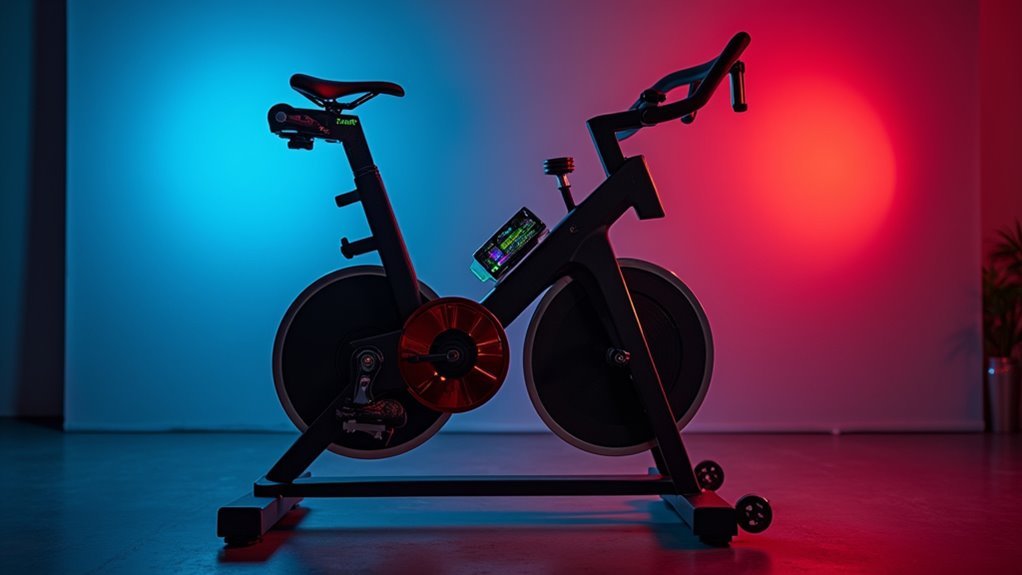Modern indoor cycling has evolved beyond simply pedaling against resistance. Tracking specific metrics now makes the difference between random workouts and strategic training. Many cyclists overlook these data points, yet they provide vital information about performance and progress. From power output to heart rate zones, these measurements offer insights that feel like having a personal coach monitoring every pedal stroke. The question remains: which metrics actually matter for your specific fitness goals?
Some of the links in this article may be affiliate links. If you make a purchase through these links, we may earn a small commission at no extra cost to you. Thank you.
Power Output (Watts): The Ultimate Performance Indicator
Power, the ultimate yardstick of cycling performance, transforms how riders understand their workouts. Unlike heart rate metrics, power output measured in watts provides an objective intensity gauge that reveals exactly how much work is being done during pedaling.
When cyclists track their average power across sessions, they gain valuable insights into their progress over time. Training with power not only enhances pedal stroke efficiency but also offers accurate calorie burn calculations based on actual energy expenditure rather than inflated estimates. The integration of smart features in modern spin bikes allows users to monitor their power output in real-time, further enhancing workout effectiveness.
The real-time watts display empowers riders to make immediate intensity adjustments, optimizing each session for maximum performance gains.
Heart Rate Zones: Optimizing Your Cardiovascular Training
Heart rate zones can be calculated using several methods, including age-based formulas or more precise lactate threshold testing to pinpoint individual training zones.
Monitoring recovery rate, or how quickly your heart rate returns to normal after exercise, provides valuable insights into cardiovascular health and fitness improvements over time.
Athletes who track their recovery rate can better assess their training effectiveness and make necessary adjustments to prevent overtraining while maximizing performance gains.
Zone Calculation Methods
When training effectively on a spin bike, understanding how to calculate your heart rate zones is essential for maximizing results. The most common method uses the formula 208 – (0.7 x age) to estimate maximum heart rate, which serves as the foundation for establishing personalized heart rate training zones.
From there, calculating zones is straightforward:
Zone 1 (50-60%)
Zone 2 (60-70%)
Zone 3 (70-80%)
Zone 4 (80-90%)
Zone 5 (90%+).
Each zone targets different fitness objectives, from fat burning to high-intensity interval training.
Monitoring exercise intensity and recovery heart rate helps cyclists track progress and estimated calories burned, ensuring effort and intensity align with cardiovascular training goals.
Recovery Rate Significance
Beyond establishing the right zones for your workouts, understanding your recovery rate reveals important insights about your overall cardiovascular health.
Recovery heart rate—how quickly your heart returns to resting levels post-exercise—is a powerful indicator of cardiovascular fitness. A healthy HRR shows a drop of at least 20 beats within the first minute after peak heart rate.
Monitoring this metric helps assess training effectiveness and prevent overtraining. For ideal recovery, utilize Zone 1 (50-60% of max) during cool-downs.
Think of recovery rate as your body’s efficiency score—just like a well-tuned engine cools down quickly, a fit cardiovascular system recovers faster, supporting better endurance and sustainable exercise intensity.
Cadence Tracking: Finding Your Ideal Pedaling Rhythm

Understanding your pedaling rhythm can transform a good indoor cycling session into a great one. Cadence, measured in revolutions per minute (RPM), is essential for optimizing power output during indoor cycling workouts. With proper cadence tracking, cyclists can balance resistance and pedaling speed for efficient energy expenditure. Regular tracking of cadence can also help enhance lower body strength while ensuring a comfortable and effective workout experience.
| Terrain Type | Ideal Cadence (RPM) | Resistance Level |
|---|---|---|
| Flat Road | 80-110 | Low to Medium |
| Rolling Hills | 70-90 | Medium |
| Hill Climbs | 60-80 | High |
| Sprints | 100-120 | Medium |
| Recovery | 85-95 | Very Low |
Monitoring cadence alongside heart rate helps cyclists meet specific fitness goals while improving overall performance. Remember, faster isn’t always better—efficiency matters most.
Training Stress Score (TSS): Measuring Workout Intensity
Training Stress Score (TSS) takes indoor cycling analytics to the next level after mastering your cadence. This powerful metric quantifies workout intensity using a formula that combines Normalized Power, Intensity Factor, and FTP to measure the cumulative stress on your body.
Tracking TSS helps cyclists balance training load and recovery needs. A higher score indicates greater fatigue, which is vital information when planning training cycles.
Don’t have power data? No problem—you can estimate TSS using Rate of Perceived Exertion for any workout.
For serious cyclists, monitoring TSS becomes especially important during tapering periods to optimize performance for upcoming events while avoiding overtraining.
Functional Threshold Power: Establishing Your Baseline

Cyclists can determine their Functional Threshold Power through various testing methods, with the 20-minute test and ramp protocol being the most common approaches for establishing this critical baseline.
Once FTP is established, riders can calibrate their personal training zones, typically ranging from Zone 1 (recovery) to Zone 5 (maximum effort), which helps optimize workout effectiveness.
Regular reassessment of FTP every 4-6 weeks guarantees training zones remain aligned with current fitness levels, allowing for progressive improvement rather than stagnation. Additionally, these training zones can enhance overall performance by improving VO2max and endurance during cycling workouts.
Power Testing Methods
To establish effective training protocols on a spin bike, riders must first determine their Functional Threshold Power (FTP).
Two primary methods have emerged as cycling metrics standards: the Ramp Test and the 20-minute test.
The Ramp Test progressively increases resistance until exhaustion, while the 20-minute test measures maximum sustainable power output, then reduces the average power by 5% to estimate FTP.
Both methods help cyclists establish training zones from recovery efforts to anaerobic zone work.
Regular testing every 4-6 weeks is essential for tracking performance improvements and adjusting intensity levels.
Heart rate data can complement these tests for thorough training insights.
Training Zone Calibration
Calibration serves as the foundation for effective training on a spin bike, with Functional Threshold Power (FTP) being the cornerstone measurement.
After completing a Ramp Test to determine your average power output, you’ll need to establish personalized training zones that reflect your current capabilities.
These zones, ranging from active recovery (55-65% of FTP) to the challenging anaerobic zone (106-120%), allow cyclists to target specific physiological adaptations.
Using a power meter alongside a heart rate monitor provides thorough performance assessments and guarantees training intensity remains appropriate.
Recalibrate your FTP every 4-6 weeks to accurately track fitness progression and make necessary adjustments to your regimen.
Kilojoules Burned: Tracking Energy Expenditure Accurately
When tracking fitness progress during indoor cycling workouts, kilojoules burned stands out as one of the most accurate metrics available.
Unlike some fitness trackers that might inflate calorie estimates, power meters on Spinner® bikes provide realistic data about your actual energy expenditure.
Kilojoules directly translate to calories burned, making them valuable for fitness goals.
You can optimize your training sessions by:
- Reviewing total kJs in your session summary
- Setting weekly kilojoule targets to motivate performance
- Using kJ tracking to gauge workout intensity
- Comparing kJ values across different rides to measure improvement
Understanding this metric helps cyclists guarantee each pedal stroke contributes meaningfully to their overall performance, especially since workout intensity can significantly boost calorie burn.
Frequently Asked Questions
What Is the Most Important Metric in Cycling?
Functional Threshold Power (FTP) measures sustainable power output over an hour, establishing personalized training zones that surpass heart rate, cadence tracking, workout duration, calorie burn, distance covered, recovery time, riding technique, and cycling efficiency metrics.
How Many Miles Is 30 Minutes on a Spin Bike?
Like a distance chameleon, 30 minutes on a spin bike typically covers 6-10 miles, varying with pedal speed, resistance levels, and workout intensity—all influencing calorie burn while supporting diverse fitness goals.
What Is the Best Fitness Tracker for a Stationary Bike?
Fitness trackers with integrated power meters offer ideal stationary bike metrics. Look for devices with accurate calorie tracking, heart rate monitoring, app compatibility, and interval functionality. User reviews highlight battery life and ease of use.
Will I Lose Weight Riding a Stationary Bike 30 Minutes a Day?
Yes, 30 minutes of daily stationary bike exercise can promote weight loss through consistent calorie burn. Maximizing workout intensity enhances fat burning and supports cardiovascular health while contributing to fitness goals with minimal time commitment.
